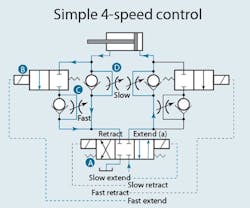The two, 2-port, 2-position valves in the meter-out circuit shown here provide two independently adjustable cylinder-extend speeds and two independently adjustable retract speeds. Therefore, the operator can select fast or slow extend modes and fast or slow retract modes; each of the four can be set at a different speed.
To illustrate how the circuit works, the flow and signal lines for fast extend are shown in color in the drawing. First, solenoid a of 4-port valve A is energized. This produces slow extend. Then, 2-port solenoid valve B is energized, which results in fast extend.
Note that for fast extend, oil flows through both flow control valves C and D. Thus, the ratio of fast flow compared to slow flow can be quite large.
This circuit was submitted by Henry R. Killian, president of WHL Controls Co. Inc., Houston, and was originally published in the January 1984 issue of Hydraulics & Pneumatics.


